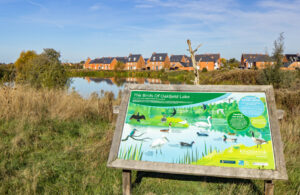Garlic, balloons, and clusters of small holes – Britain’s most unusual phobias revealed

Over one third of Brits (37%) suffer from a phobia, according to a new survey from consumer genetics company, 23andMe, which has uncovered some of Britain’s most unusual scares – and they’re not all what you’d expect.
Among the list of the less known phobias were trypophobia (fear of clustered small holes, bumps or patterns – 10%), arachibutyrophobia (fear of peanut butter sticking to the roof of your mouth – 6%) and globophobia (fear of balloons – 8%). Some of the rarest food phobias include alliumphobia (fear of garlic – 4%), mycophobia (fear of mushrooms – 5%) and acerophobia (fear of sour tastes – 5%).
The research also delved into some of the most common phobias in Britain, such as arachnophobia (fear of spiders), which is a concern for 31% of the population with phobias, claustrophobia (fear of confined spaces – 23%) and glossophobia (fear of public speaking – 23%). The fear of snakes (ophidiophobia – 21%) and flying (pteromerhanophobia – 18%) also topped the list of common phobias.
One in five affected Brits (21%) have reported that their phobias have become worse with age. However phobias do start young, with the average age of first experiencing them being 12 years old.
Experts from 23andMe have revealed that the secret to some of these fears could lie in the genes of the people who suffer from them. Data revealed that 51% of 23andMe research participants report having introvert personality characteristics, and up to 17% are more likely to have a fear of public speaking, based on their genetics. The data also revealed that a third of Brits (39%) are more likely than average to have a fear of heights, based on their DNA.
Alisa Lehman, Senior Product Scientist at 23andMe commented: “ From spiders to belly buttons, it’s clear that Brits suffer from a wide range of phobias! And whilst many of these may be learned, we have explored the relationship between certain phobias and genetics to see whether our DNA can influence our propensity to suffer from these. Interestingly, our scientists found over 800 genetic markers associated with the fear of public speaking, revealing that 17% of Brits are predisposed to this fear, based on their genetics. Separately, we also found that around a third of Brits are more likely than average to have a fear of heights, based on their DNA. This phobia is thought to arise from the brain missing visual input from nearby objects to help maintain balance.
However, whilst genetics may play a small role in why people suffer from these phobias, this does not mean they can’t learn to overcome them! It simply offers a possible explanation as to why some fear it more than others.”
Having a phobia is nothing to be ashamed of, however, with 70% percent of Brits believing it is perfectly reasonable to be concerned about unusual objects or things. In fact, a new and common phobia is Nomophobia (fear of being without your mobile phone), which afflicts 13% of us with phobias.
Despite this, sadly it’s been revealed that a fifth of suffering Brits (19%) are too embarrassed to tell their friends and family about their phobias, although the same amount (19%) have sought, or plan to seek, help from a professional to overcome their debilitating fears. Regardless of our natural or learned phobias, there are techniques which all Brits can use to manage their anxieties to help overcome their fears.
Christopher Paul Jones, Harley Street’s Phobia Expert, comments :
“Despite the interesting relationship between genetics and certain phobias, often, phobias are created from learned behaviour, as most originate in childhood. One common example would be a spider phobia, where a young child repeatedly experiences their parents’ reaction (fear) and this in effect ‘teaches’ or ‘passes on the phobia’.
“The good news is, whether the cause is genetic or the behaviour is learned, it can be ‘undone’ relatively easily. Often, people resist seeking help for a phobia as they have been led to believe that it is for life, and is not treatable, but just like fears (which are less extreme than a phobia), phobias are reversible and treatable.
“The first step that I would suggest to anyone who has a phobia is to check that it actually is a phobia. If you have fear about something but can still do the thing that you are scared of, then that is fear rather than a phobia. Once you have determined this, the next step is to try and accept it, and understand that it is nothing to feel embarrassed about. Don’t be ashamed if you need to seek help from a professional!”
Top tips for facing your phobias
Add in some humour – a spider isn’t so scary if you throw on a wig and some roller skates. Injecting humour whilst thinking about the thing that you are scared of instantly changes the feeling and this disarms your phobia.
Lock in a good feeling – when experiencing the phobia, think of a time when you felt really good, and then squeeze your thumb and forefinger together. Creating this positive feeling is a technique specialists call ‘anchoring’.
Address your emotional state – when you’re afraid your heart is pounding and you are in a state of panic. Cross your arms, and rub your arms up and down with your hands. This will soothe you, and replace adrenaline and cortisol with dopamine and oxytocin.
Change the aesthetics – the thing that you are scared of seems huge and is towering above you – so make it black and white, and imagine it shrinking until it’s really tiny. Playing with the aesthetics can remove the emotional connection and charge from your fear and make it more faceable.
Balance yourself – take a deep breath in, place your left hand over your heart, and take a moment to breathe and lower your heart rate. This is a simple technique but helps you to come to a place of balance.
Most common phobias for Brits revealed:
Acrophobia – fear of heights 37%
Arachnophobia – fear of spiders 31%
Claustrophia – fear of confined spaces 23%
Glossophobia – fear of public speaking 23%
Ophidiophobia – fear of snakes 21%
Pteromerhanophobia – fear of flying 18%
Trypanophobia – fear of needles 17%
Emetophobia – fear of vomiting or seeing others be sick 16%
Entomophobia – fear of insects 15%
Aquaphobia – fear of water or swimming 14%
Decidophobia – fear of making decisions 14%
Nomophobia – fear of being without a mobile phone 13%
Cynophobia – fear of dogs 12%
Ergophobia – fear of the workplace 11%
Trypophobia – fear of clusters of small holes, bumps or patterns 10%
Deipnophobia – fear of dining with others 10%
Astraphobia – fear of storms 9%
Phobophobia – fear of phobias 8%
Chrematophobia – fear of money 8%
Globophobia – fear of balloons 8%
Eisoptrophobia – fear of mirrors 7%
Retrogenraflexaphobia – fear of moving backwards 7%
Sidonglobophobia – fear of cotton wool balls 7%
Vestiphobia – fear of clothing 6%
Arachibutyrophobia – fear of peanut butter sticking to the roof of your mouth 6%
Ichthyophobia – fear of fish 6%
Numerophobia – fear of numbers 6%
Hippopotomonstrosesquippedaliophobia – fear of long words 6%
Omphalophobia – fear of belly buttons 6%
Cilantrophobia – fear of coriander 6%
Pogonophobia – fear of beards 6%
Ephebiphobia – fear of adolescents 6%
Trichophobia – fear of hair 5%
Linonophobia – fear of string 5%
Nelophobia – fear of glass 5%
Fructophobia – fear of fruit 5%
Lachanophobia – fear of vegetables 5%
Acerophobes – fear of sour tastes 5%
Mycophobia – fear of mushrooms 5%
Gelotophobia – fear of hearing laughter 5%
Octophobia – fear of the number eight 5%
Xanthophobia – fear of the colour yellow 5%
Geniophobia – fear of chins 4%
Alliumphobia – fear of garlic 4%
Xocolatophobia – fear of chocolate 4%




